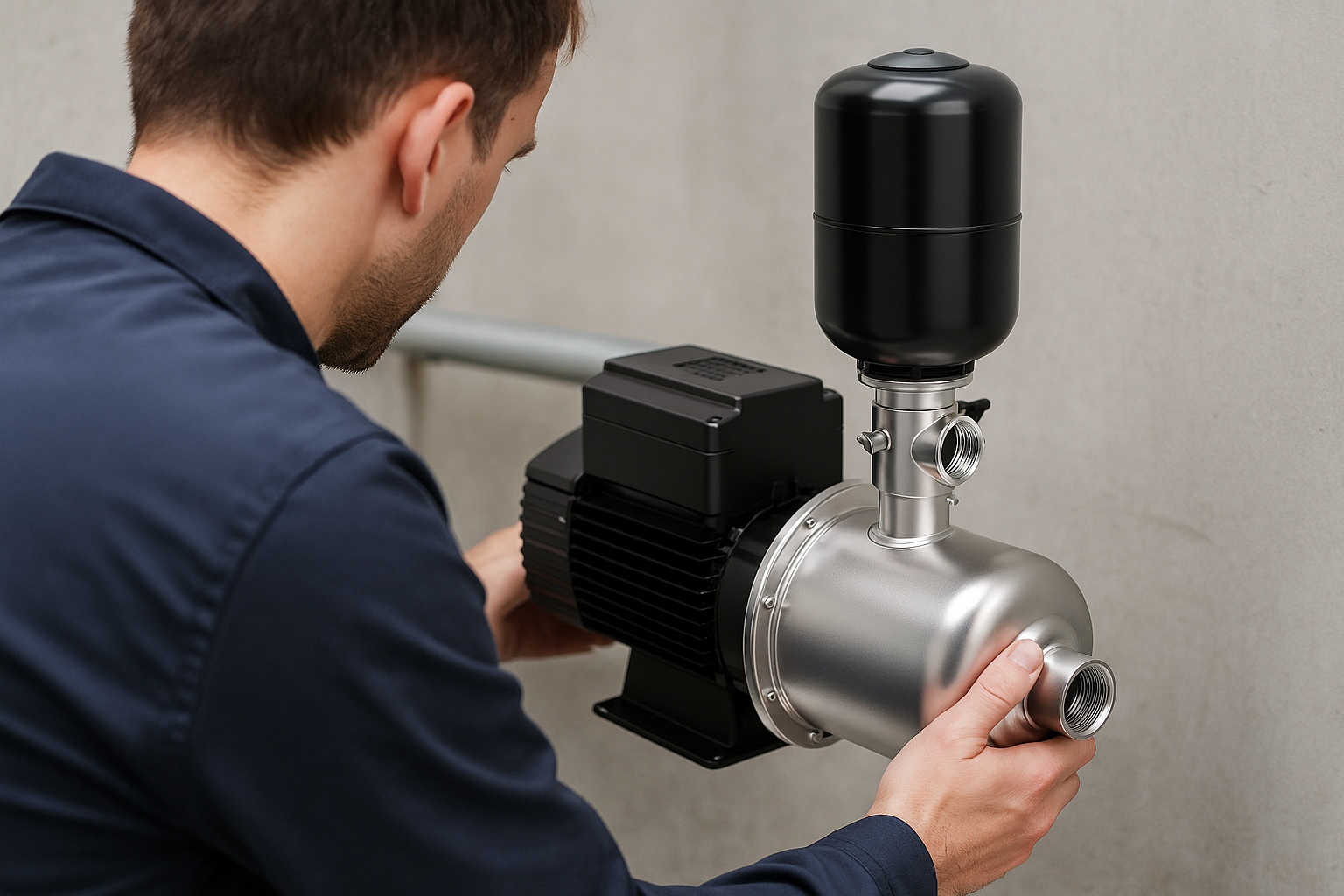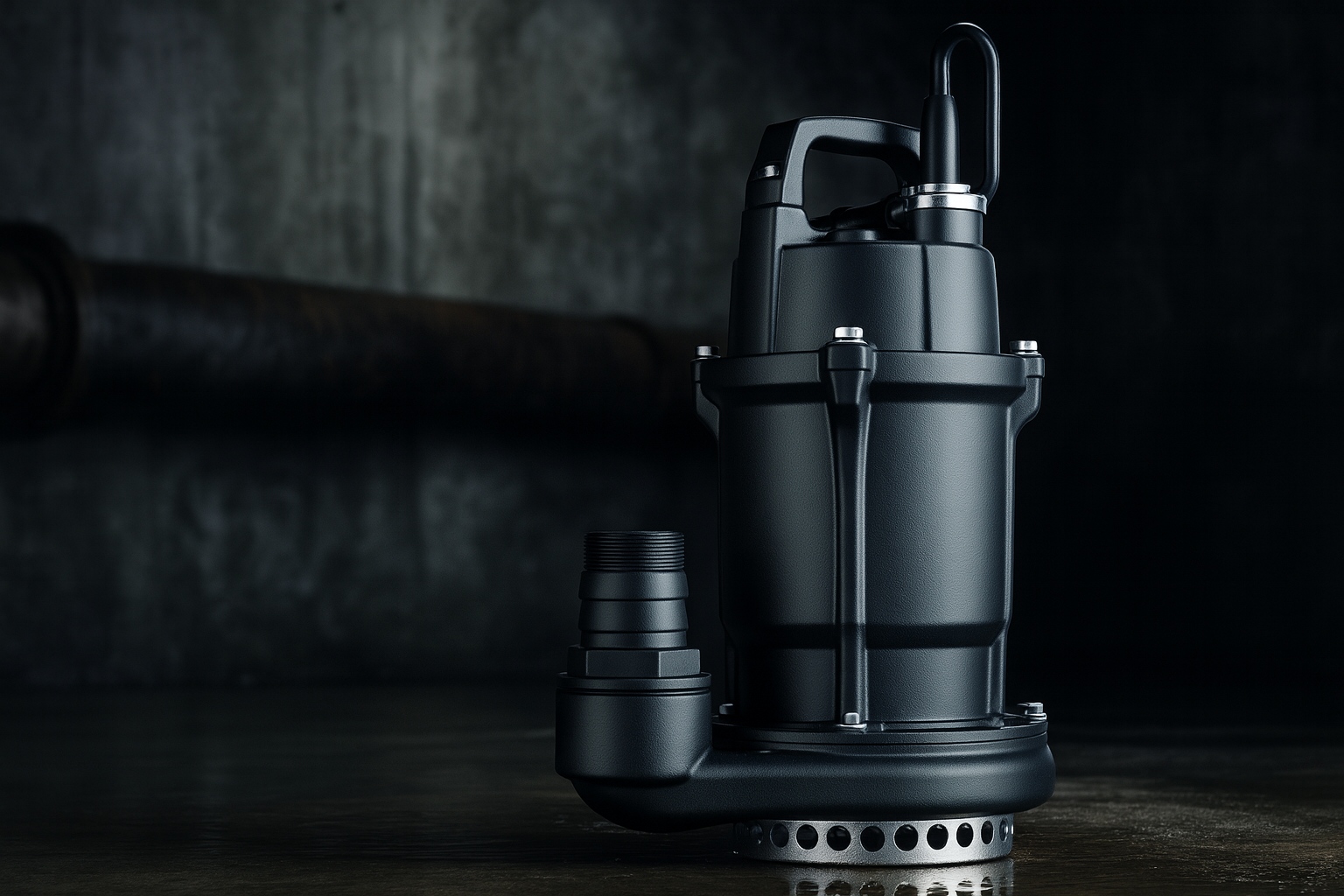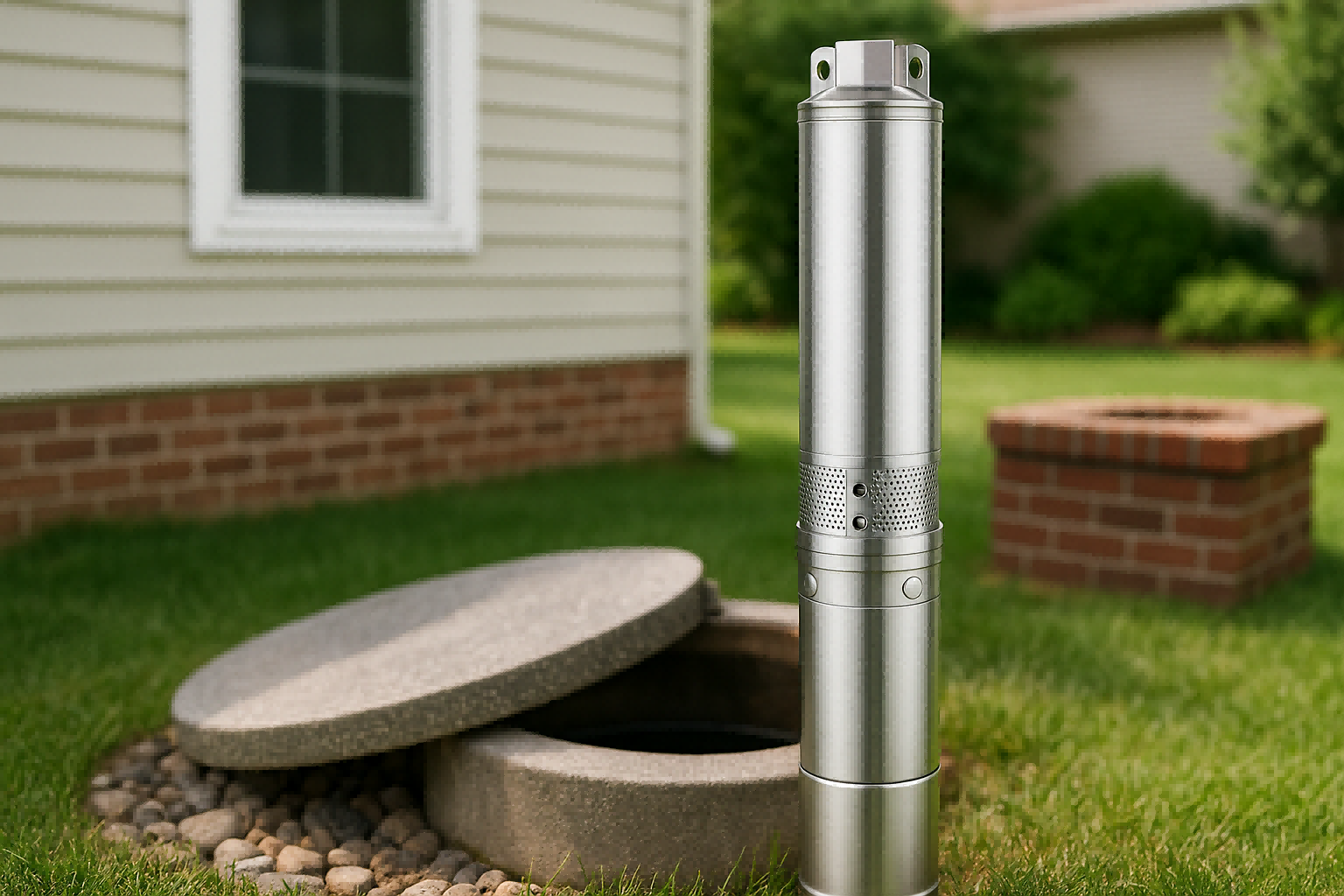Is your water flow weak or inconsistent?
A failing water pump can disrupt your daily life and lead to costly damage.
The main signs you need a new pump include no water, poor pressure, dirty water, strange noises, or the pump running constantly.
These symptoms often point to an aging or malfunctioning system that is inefficient and prone to complete failure.

Experiencing water issues in your home can be frustrating.
It can range from a minor annoyance like a weak shower to a major problem like having no water at all.
Recognizing the early warning signs of a failing water pump is the key to preventing a complete system breakdown.
This guide will walk you through the most common signs that your pump is in trouble and explain what might be happening inside the system.
Understanding these signals will help you make an informed decision on whether to repair or replace your unit, ensuring a reliable water supply for your household.
1. No Water
Is turning on the tap met with silence?
A complete lack of water is a clear sign of a major pump failure, leaving you without a basic necessity.
This is the most obvious sign that your water pump has a serious problem.
It could mean the motor has completely failed, there's a major leak, or a critical electrical component has broken down.
Immediate action is required to diagnose the issue and restore your water supply.
When no water flows, the problem is urgent and requires a clear understanding of what could go wrong.
A complete pump failure can stem from several critical issues within the system.
It's not just an inconvenience; it's a signal that the heart of your water supply has stopped working.
Let's explore the technical reasons behind this drastic symptom.
Motor or Electrical Failure
The most common cause is a dead motor.
This can happen if the pump overheats, if there's an electrical short, or if it simply reaches the end of its operational life.
Modern, intelligent pumps have built-in protections to prevent this.
- Stall Protection: This feature stops the motor if it gets stuck, preventing burnout.
- Overheating Protection: Sensors monitor the temperature of both the motor and the electronic board, shutting the system down before damage occurs.
- Voltage Protection: The system will not operate if the incoming voltage is too high or too low, protecting the sensitive electronics from power grid fluctuations.
Dry-Run Catastrophe
Another cause is severe water shortage, also known as running dry.
If the well or water source runs out, a traditional pump will keep running, quickly destroying its motor and seals.
An advanced pump uses smart technology to handle this.
It has a multi-stage dry-run protection system.
| Attempt | Action | Rest Period |
|---|---|---|
| 1st | Self-primes for 360 seconds | 5 minutes |
| 2nd - 4th | Attempts to find water | 2 hours |
| 5th+ | Attempts to find water | 6 hours |
This intelligent algorithm protects the pump from damage while periodically checking if the water source has been restored.
It saves the pump and conserves energy.
2. Air in the Pipes
Do your faucets spit and sputter before water flows?
This irritating noise indicates that air is getting into your water lines, a common sign of a failing pump or leaking pipes.
When faucets spit air, it often means the pump is drawing in air along with water.
This can happen if the water level in your well drops below the pump's intake or if there's a crack in the pipe leading to the pump.
It reduces water pressure and puts extra strain on your system.
Hearing a sputtering sound from your taps is more than just an odd noise.
It's a clear indication that your plumbing system's integrity is compromised.
Air should not be in your water lines.
Its presence points to a suction-side leak or a problem with the pump's ability to draw water effectively.
A pump that is not properly positioned or a leak in the pipe are common culprits.
Suction and Leak Issues
A pump's ability to pull water is measured by its suction lift.
High-quality pumps can have a strong suction lift, often up to 8 meters.
This allows them to draw water from deeper sources without pulling in air.
However, if there is a crack or a loose fitting in the suction pipe between the well and the pump, the pump will pull air through that gap.
This is especially true when the pump first starts up.
Intelligent Leak Detection
Old pumps have no way of knowing if there's a small leak.
They just run longer to compensate, wasting energy.
Modern intelligent pumps have a built-in defense against this.
They are equipped with a pipeline leak warning system.
The pump's internal computer monitors pressure patterns.
If it detects a slow, consistent pressure drop that indicates a small leak, it will alert the user.
This allows you to fix small leaks before they become big, damaging problems.
It saves water, prevents property damage, and reduces the strain on the pump itself.
3. The Pump Is Constantly Running
Do you hear your water pump running nonstop?
A pump that never shuts off is working too hard, wasting electricity and heading for an early burnout.
A continuously running pump is a major red flag.
It indicates that the system is never reaching its target shut-off pressure.
This could be due to a significant leak in your plumbing, a faulty pressure switch, or a worn-out pump that can no longer build enough pressure.
A pump that runs all the time is not just a noise nuisance; it's a huge energy drain and a sign of a deep-rooted problem.
In a traditional system, the pump's job is to fill a pressure tank and then turn off.
If it can't reach the "off" pressure, it will run forever until it fails.
This is where the difference between old technology and modern systems becomes incredibly clear.
The Problem with Fixed-Speed Pumps
Traditional pumps are "fixed-speed."
They are either 100% on or 100% off.
When you open a tap, the pressure drops, and the pump kicks on at full power.
It runs until the pressure tank is full, then shuts off abruptly.
If there's a leak or the pressure switch is broken, it will never receive the signal to stop.
The Smart Solution: Variable Frequency Drive (VFD)
A modern pump uses a Variable Frequency Drive (VFD).
This technology is much smarter.
Instead of running at full speed, a VFD pump adjusts its motor speed in real-time to meet your water demand.
- Low Demand: If you only open one small faucet, the pump runs slowly, using very little energy.
- High Demand: If you run a shower and a washing machine, the pump speeds up to maintain pressure.
This means the pump only uses the exact amount of energy needed.
It rarely runs at 100% speed.
This VFD technology, combined with an efficient pressure tank, can reduce how often the pump needs to cycle on and off by up to 70%.
This saves a massive amount of energy and drastically reduces wear and tear, making the pump last much longer.
4. Poor Water Pressure
Is your shower more of a dribble than a blast?
Weak water pressure throughout your home is a frustrating issue and often points directly to a problem with your water pump.
Poor water pressure can mean your pump is undersized for your home's needs.
It might also indicate that the pump's impeller is worn out, or the pressure tank has lost its charge.
It struggles to push water effectively to all your fixtures.
Inconsistent and low water pressure can ruin simple daily tasks like showering, washing dishes, or watering the garden.
It's one of the most common complaints related to home water systems.
The cause often lies with a pump that either lacks the power or the intelligence to manage the varying water demands of a modern household.
A traditional pump simply cannot provide a truly stable water pressure experience.
The Flaw of Traditional Pressure Systems
Standard pumps work with a pressure switch that has a range, for example, 40-60 PSI.
The pump turns on at 40 PSI and off at 60 PSI.
This means your water pressure is always fluctuating between these two points.
You can feel this change while you're in the shower.
When the pump is undersized or old, it struggles to even reach the 60 PSI cutoff, leading to overall weak pressure.
The Modern Standard: True Constant Pressure
The goal of a modern water system is to deliver a consistent, unchanging water pressure.
This is achieved by combining a VFD with a high-efficiency Permanent Magnet Synchronous Motor (PMSM).
This combination creates a truly intelligent system.
- You Set the Pressure: You can choose your desired water pressure, for instance, a steady 50 PSI.
- Sensors Monitor: A high-precision pressure sensor constantly monitors the pressure in your pipes.
- The VFD Adjusts: When you open a tap, the sensor detects a tiny pressure drop. It instantly tells the VFD to increase the motor's speed (RPM) just enough to bring the pressure back to exactly 50 PSI.
This all happens in milliseconds.
The result is a perfectly stable water pressure, no matter how many taps are open.
It feels more like a city water supply, providing a powerful and comfortable experience while being incredibly energy efficient.
5. Dirty Water
Is your water cloudy or filled with sand or silt?
Dirty water is a serious warning sign that your pump may be failing or is not properly matched to your well.
Water containing sediment can mean the pump's filter screen has failed.
It could also mean the pump is too powerful for the well, pulling up debris from the bottom.
In some cases, the pump itself may be corroding and shedding particles into your water supply.
Never consume dirty water.
Seeing dirt, sand, or rust-colored particles in your water is alarming.
It's a clear sign that something is wrong with your well or your pump.
This issue must be addressed immediately, as it impacts both the quality of your water and the longevity of your entire plumbing system, including appliances.
The problem can originate from the well, the pump's position, or the materials the pump is made from.
Pump Sizing and Placement
If a pump is too powerful for a well, it can create enough turbulence to stir up sediment from the bottom.
If it's placed too low in the well casing, it will naturally pull in more debris.
A properly sized and positioned pump is crucial for drawing clean water.
This is a task best handled by a professional who can assess your well's depth, recovery rate, and your home's water needs.
The Importance of High-Quality Materials
Over time, a low-quality pump can contaminate the water itself.
Pumps built with inferior materials can rust and corrode.
This corrosion not only weakens the pump but also releases particles into your water supply.
This is why the choice of materials is critical for durability and water safety.
Look for pumps constructed with premium, corrosion-resistant components.
- Impeller: The impeller is the spinning part that moves water. An impeller made from AISI 304 stainless steel is highly resistant to rust and wear. It ensures a long service life and won't contaminate the water.
- Housing: The pump's outer case should be made from durable, non-corrosive materials. A UV-resistant ABS housing protects the pump from the elements if it is installed outdoors.
Investing in a pump made with superior materials ensures that the pump itself will not become a source of contamination, giving you peace of mind and clean, safe water.
6. Increase in Electric Bill
Has your electricity bill suddenly spiked without explanation?
Your water pump could be the hidden energy vampire, working inefficiently and drawing excess power.
When a pump's components wear out, it has to run longer and harder to do the same job.
This increased effort translates directly into higher electricity consumption.
A faulty pump running constantly is one of the quickest ways to see a shocking increase in your utility costs.
A sudden jump in your electric bill is a financial sign that something is mechanically wrong in your home.
Before you blame your air conditioner or heater, you should consider your water pump.
An old, inefficient pump can be one of the most energy-intensive appliances in a household, especially when it's not working correctly.
Its inefficiency forces it to draw more power for longer periods.
Why Old Pumps Waste Energy
A traditional fixed-speed pump is inherently inefficient.
It always runs at maximum power, even when you only need a small amount of water.
Think of it like driving a car by only pressing the accelerator to the floor and then slamming on the brakes.
It's powerful but incredibly wasteful.
When parts like bearings or the motor start to wear down, friction increases.
The motor must work even harder and draw more current to overcome this friction, causing your power consumption to skyrocket.
The Efficiency of Smart Pump Technology
A modern constant pressure pump with a VFD is designed from the ground up for energy efficiency.
The key is its ability to adapt.
By precisely matching motor speed to water demand, it eliminates wasted energy.
This can lead to energy savings of up to 50% or more compared to a traditional system.
Here’s how it saves you money:
| Feature | How It Saves Energy |
|---|---|
| VFD Control | Runs the motor only as fast as needed, drastically cutting power use during low-demand periods. |
| PMSM Motor | Permanent Magnet Synchronous Motors are more efficient than standard induction motors, converting more electricity into pumping power. |
| Soft Start/Stop | Eliminates the massive power surge that occurs when a traditional motor kicks on, reducing peak energy demand. |
An investment in a new, intelligent pump often pays for itself over time through significant reductions in your monthly electricity bills.
7. Bad Tasting Water
Does your water have a strange metallic or unpleasant taste?
A change in your water's taste can sometimes be traced back to a deteriorating water pump or a failing filter system.
If the pump's internal components begin to corrode, they can leach metallic tastes into the water.
Furthermore, if the built-in filters or screens are damaged, the pump can pull in bacteria and other underground contaminants that affect the taste and safety of your water.
Stop drinking the water and have it tested.
The taste of your water is a direct indicator of its quality.
Any sudden change to a metallic, bitter, or otherwise "off" flavor should be taken seriously.
While several factors can influence water taste, your pump system plays a crucial role as a gatekeeper.
A breakdown in the pump can introduce unwanted elements that taint your water supply, posing potential health risks.
Contamination from Pump Corrosion
The most direct way a pump can affect taste is through corrosion.
Pumps made with low-grade cast iron or other susceptible metals can rust over time.
This rust, primarily iron oxide, can break off and dissolve into the water, giving it a distinct metallic taste.
This is more than just an unpleasant flavor; it's a sign that the pump is physically breaking down from the inside out.
Using pumps built with high-grade materials like stainless steel impellers and brass fittings is essential to prevent this type of contamination.
Failure to Filter
Pumps are the first line of defense in drawing water from your well.
They are typically fitted with intake screens to filter out larger debris, sand, and silt.
If this screen becomes damaged or clogged, two things can happen.
- Contaminants Get Through: Debris and bacteria that were previously blocked can now enter your water system.
- Iron Bacteria Growth: A clogged screen can create an environment where iron bacteria thrive. These organisms can produce a slimy buildup and cause unpleasant tastes and odors.
It is highly recommended to get your well water tested by a lab annually.
This will give you a clear picture of its quality and help you determine if your pump system is performing effectively.
8. Clicking Sounds
Do you hear a rapid clicking sound coming from your pump's pressure tank?
This sound is often the pressure switch rapidly turning the pump on and off, a sign of a serious issue that will quickly destroy the pump motor.
This rapid cycling is usually caused by a problem with the pressure tank, such as a waterlogged or burst air bladder.
The system can't maintain pressure correctly, causing the switch to click on and off repeatedly.
This puts immense strain on the pump's motor and electrical components, leading to premature failure.
That fast clicking noise is the sound of your pump killing itself.
Each click represents the pump's motor starting and stopping.
This process, known as short cycling, is one of the most damaging things that can happen to a water pump.
It generates excessive heat in the motor windings and causes extreme wear on the starting components.
If left unchecked, it will lead to a complete and costly motor burnout.
The Role of the Pressure Tank
To understand short cycling, you must understand the pressure tank.
The tank contains a bladder of air that acts as a cushion.
When the pump runs, it pushes water into the tank, compressing the air.
This stored pressure is what sends water to your faucets.
It allows the pump to turn off and rest.
If the air bladder inside the tank leaks or ruptures, the tank becomes "waterlogged."
There's no air cushion left.
As soon as you open a tap, the pressure drops instantly, and the switch clicks the pump on.
When you close the tap, the pressure spikes instantly, and the switch clicks the pump off.
This leads to the rapid on-off clicking sound.
Advanced Pump Protection
An old pump has no defense against short cycling.
It will continue to rapidly switch on and off until its motor fails.
A modern, intelligent pump, however, has safeguards built into its electronics.
The onboard computer can recognize the abnormal pressure fluctuations and frequent starts that characterize short cycling.
Sophisticated systems will have protections like stall and overheating sensors that can shut the pump down to prevent catastrophic damage.
Some systems may even display an error code to alert you to the problem.
This intelligence acts as a safety net, protecting your investment and preventing a small issue like a bad pressure tank from destroying your entire pump.
Conclusion
Recognizing these eight signs early can save you from high bills, major damage, and the serious inconvenience of being without water.
Modern pumps offer superior performance, protection, and efficiency.
FAQs
What is the average lifespan of a well pump?
The lifespan of a well pump is typically 8 to 15 years.
Its longevity depends on factors like pump quality, usage frequency, and water quality.
How much does it cost to replace a water pump?
Replacing a standard submersible well pump can cost from $975 to $2,800.
The final price depends on the pump type, well depth, and labor rates.
Can I replace a well pump myself?
DIY replacement is possible for some accessible pumps but is often complex.
It involves electrical work and specialized tools, so professional installation is usually recommended for safety and correctness.
What happens if my well pump is too small for my house?
An undersized pump will lead to low water pressure, especially when multiple faucets are in use.
It will also run excessively, causing premature wear and higher energy bills.
Why does my new well pump have low pressure?
Low pressure with a new pump could be due to incorrect installation or sizing.
It might also be caused by leaks in the pipes or a problem with the pressure tank.
How often should a well pump be serviced?
A well pump and system should be inspected by a professional every one to two years.
Regular checks can identify potential issues before they cause a major failure.
Is a constant pressure water pump worth it?
Yes, a constant pressure pump provides a steady, strong water flow similar to city water.
They are also much more energy-efficient, which can lead to significant savings on electricity bills.








